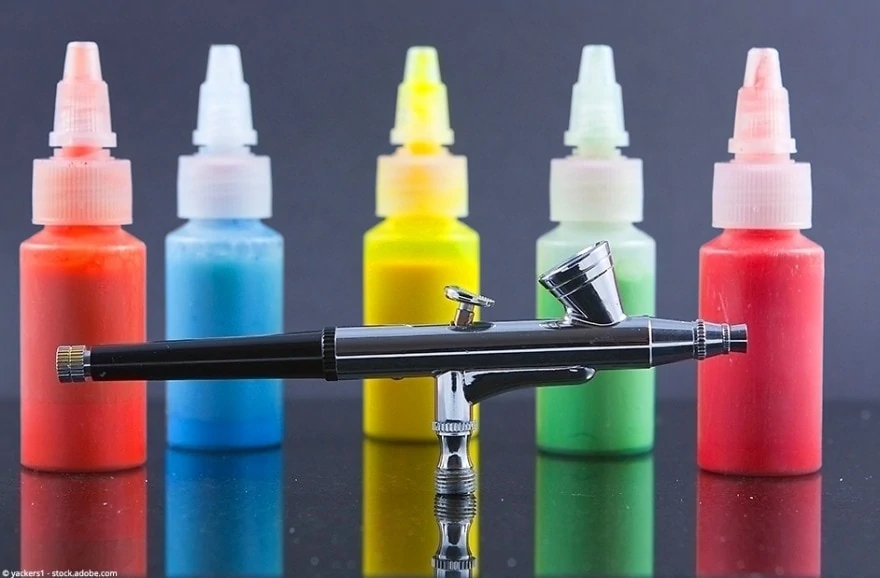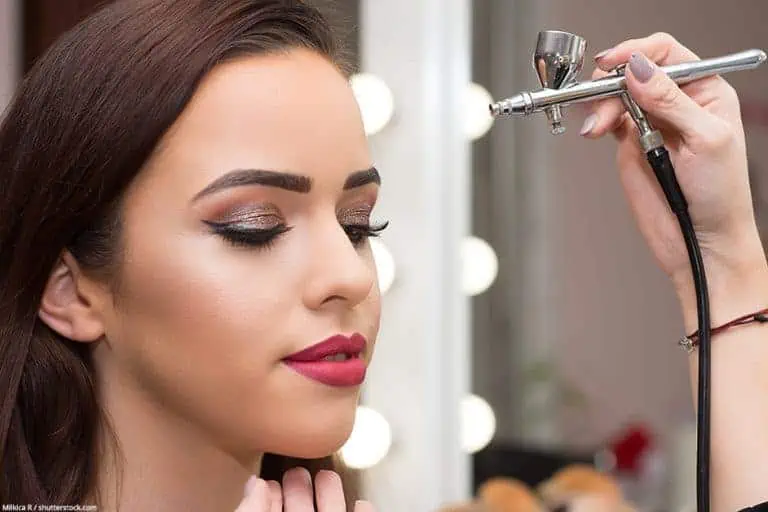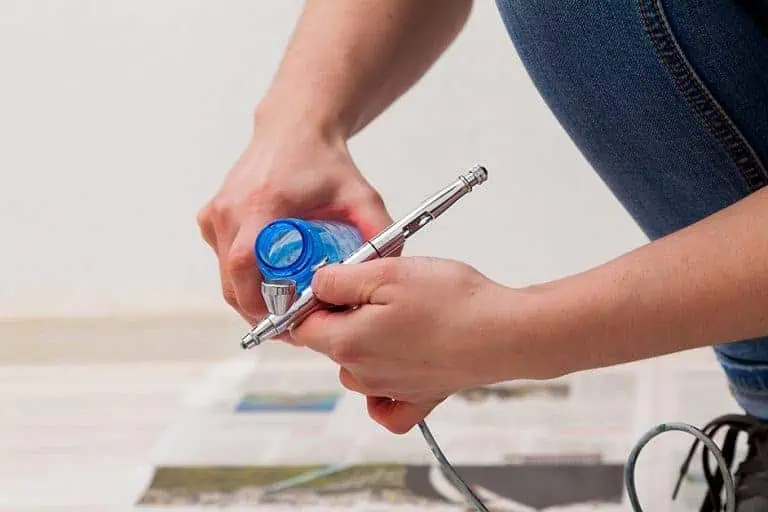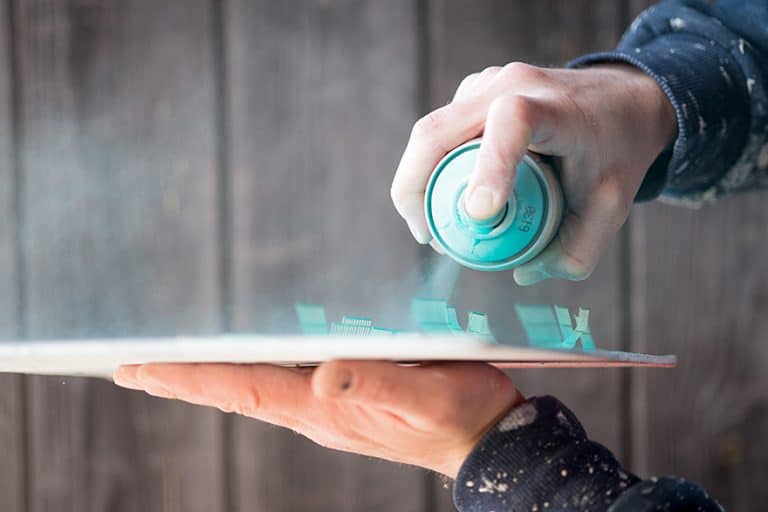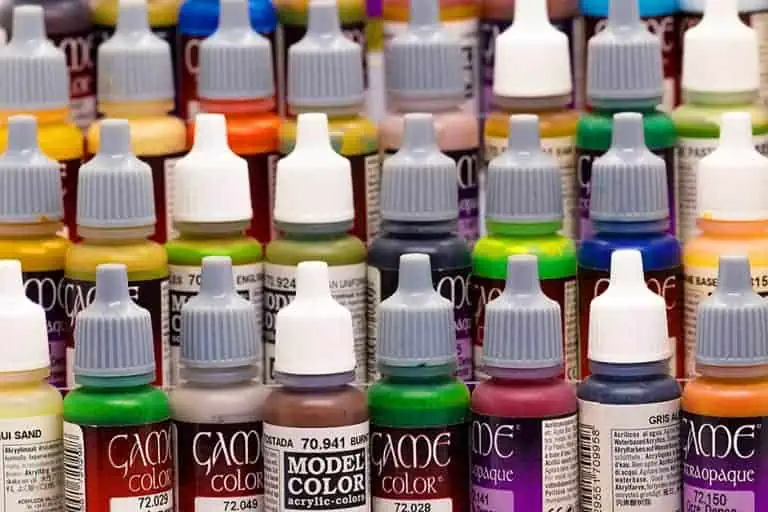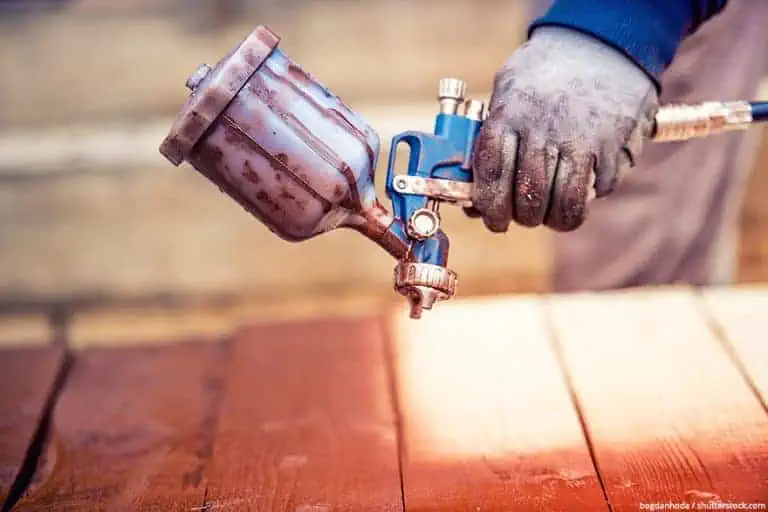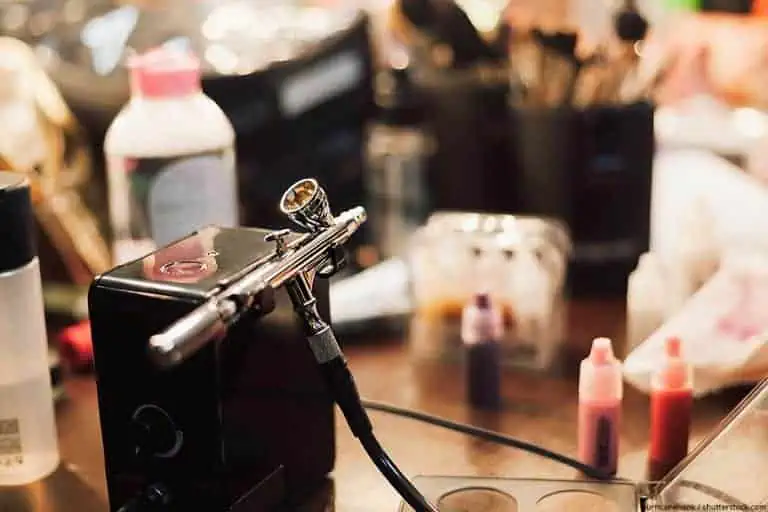Airbrush Paint Guide – Suitable Colorants for Airbrushing
This post may contain affiliate links. We may earn a small commission from purchases made through them, at no additional cost to you.
If you want to create art with an airbrush gun, you won’t be able to avoid the question of which colors are the best. Besides the basic question of which paints are suitable for an airbrush, there are several well-known manufacturers to choose from. We tell you which airbrush paints are the best, whether you should buy them individually or rather an airbrush paint set and which airbrush paints are suitable for model making.
Table of Contents
Which Airbrush Paints are the Best for your Art?
The choice of the right airbrush paints is crucial for every artist, because these colors have a considerable influence on the resulting art object. For the airbrush technique, normal paints are usually not suitable because they contain large pigment particles. Therefore, highly pigmented paints, with smaller pigment particles, should be used.
In general, all paints marked as airbrush can be used for airbrush guns. In addition, there are acrylic airbrush paints for every imaginable purpose. These are often optimized for a special art form or a specific base:
- Some manufacturers attach importance to good adhesive properties, especially in the field of custom painting.
- The airbrush paint used in model making must, in addition to optimal adhesive properties, generally have a high brilliance as well as easy application. This is especially important in the area of dioramas, as here the smallest details have to be worked out. An exception to this is airbrush paints for model making in the military sector, because here the colors should be particularly matt.
- Food-safe airbrush paints are particularly suitable for the design of cakes and pastries and have been very popular for years.
- For body painting, dermatologically tested airbrush paints are indispensable.
- Nail design using airbrushes has also been experiencing a boom in the last few years. Here the artist uses water-soluble acrylic paints, which have to be shaken well beforehand in order to mix the pigments optimally. One differentiates between transparent and opaque, meaning covering, nail art paints. Note that transparent colors require a primer.
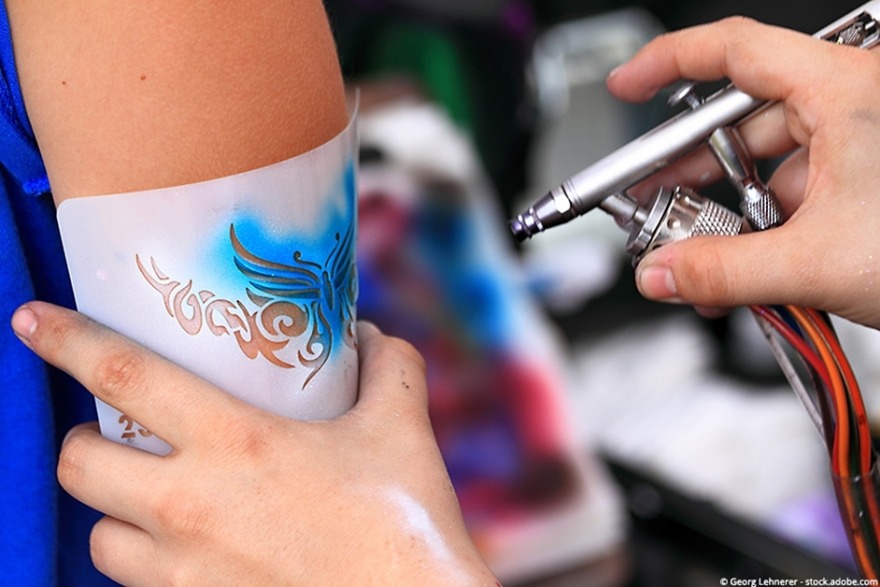
Apart from the special subdivisions, there are two different color bases:
- Water-based airbrush paints are basically acrylic paints based on an acrylic binder diluted with water and plastic or acrylic resin dispersion. They also contain inorganic or organic pigments, or special effect pigments. After the application of the paint, the contained water evaporates so that the paint layer dries. For cleaning the airbrush gun, water as well as special cleaners from the same paint manufacturer can be used.
- Solvent-based airbrush paints are those that work with the help of a solvent. If you use such paints, you must clean your airbrush after use with acetone or nitro thinner, as these are also solvent-based.
By the way, airbrush paints are usually available in pipettes so that you can dose them precisely. If you are unsure, you can also buy suitable airbrush paint sets. If you’re new to airbrushing, the airbrush sets often already contain paint.
Guide for the Application of Airbrush Paint
Beginners may shy away from using an airbrush because they think it is very complicated to work with. This is not entirely correct – all you need is a little practice and the right basic knowledge. Of course, we will be happy to help you and tell you what you need to know about airbrush paint processing.
Airbrush Paint Dilution / Mediums
Even if a paint is marked as airbrush, it should still be thinned a little so that you can spray it optimally. Diluting offers you many advantages:
- Fewer splashes occur during work, which means that your work has fewer defects; in addition, regular cleaning of the surroundings is no longer necessary
- You can create more detailed works of art because you need less pressure when handling the gun and can work closer to your artwork
- The paint used is not so granular
- Errors are easier to correct or do not occur at all
- The viscosity of your paints is reduced so that its flow properties are improved
However, it should be noted that dilution reduces the pigment content of the paint, which also reduces the luminosity of the paint.
Mediums with which you can dilute the paints are either distilled water or a suitable fluid medium. However, distilled water is only recommended in very small amounts and should only be used in emergency situations, for example if you want to airbrush paint yourself but find out at the last moment that you lack a high-quality fluid medium. Distilled water is not a binding agent and in high doses can cause the paint cover to crack open. More suitable is definitely a good commercial fluid medium.
This is nothing more than a binder that lacks pigments. Usually, you don’t need much of it, because such a fluid medium is rather thin-bodied. It is important that you choose the correct medium, because there are also mediums available that thicken the paint instead of diluting it. The quality of the fluid medium and its influence on the drying time should also be considered. It is better to use a high-priced, high-quality product. It would be a great pity if you put hours of painstaking work into a work of art only to find that it contains flaws because of the wrong fluid medium.
Also, the dilutant should not contain alcohol as a base. This will make the airbrush paints dry too rapidly, causing the nozzle of the gun to clog up relatively quickly.
By the way, normal acrylic paint is conditionally suitable for spraying with an airbrush, if you dilute it correctly. However, you must make sure that you use highly pigmented acrylic paint, otherwise the nozzle of your airbrush gun can become blocked.
Airbrush Paint Mixing
Airbrush paints are mixed together to create color gradations and transitions. You should proceed very carefully, because an extremely small amount is usually enough to make a big difference. It is better to approach the right color slowly. This is especially important if you want to create gradients and keep the transitions between the different shades very subtle.
You can do this by stirring the colors in the paint container of your pistol, for example. If you are unsure about the color shade, mix the paint in a cup and spray a trial run onto a piece of paper before you start working on your real art object.
If you want to switch between different colors, you should always clean your airbrush gun so that the fresh paint does not mix with the residues of the paint you used before.
To mix paint with a medium, you also use a pipette. Mix both medium and paint until the correct consistency is achieved. You can recognize this by the fact that when the paint flows in the transparent container, it does not create any drops, but rather a transparent smear of paint.
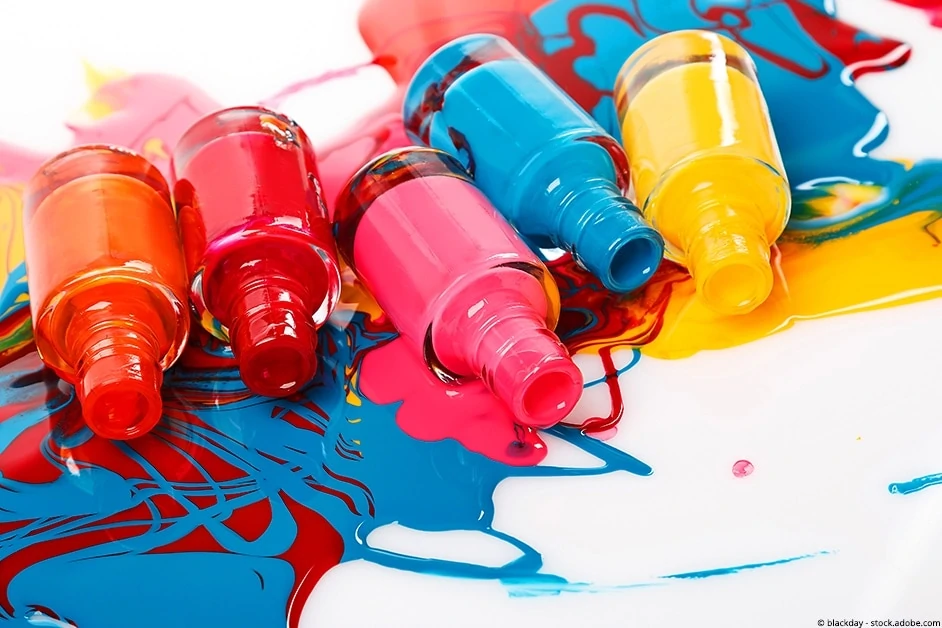
Select the Right Nozzle Size
Which nozzle size is right cannot be answered in general, as it will depend on the type of project. In general, you can distinguish between fine, medium, and thick nozzle sizes, where fine nozzles are used for very fine details and large nozzles for flat elements. The exact sizes and designations are as follows:
- Fine: XF or F; 0,8 – 25 mm
- Medium: IL or M; 1,5 – 38 mm
- Thick: HD or L; 3,2 – 50 mm
Clean Airbrush after use
When you are finished, you should clean your airbrush, otherwise the nozzle will clog. But you also have to remove the previously used paint every time you change the color, since there is also a risk of unwanted mixing. Cleaning is part of working with the airbrush gun and should be ritualized so that you don’t forget it. This way you increase the life span of your tool.
First, the remaining paint is poured out of the container. Then you use a suitable airbrush cleaner and cotton swabs to remove the paint residue. Repeat this step until the cotton swab no longer discolors. Take note that the cleaner should not contain ammonia, otherwise there is a risk of damage to the nozzle of your gun in the long run.
Now pour some more of the cleaner into the paint container and spray with the airbrush as if you were working with it. Once it sprays only clear cleaning fluid, your gun is clean. Now you can remove the remaining cleaner from the container and dry it. You should also continue to operate the gun until no more liquid is sprayed.
Notes on the Application of Solvent-based Airbrush Paints
If you want to work with airbrush paint, you should pay attention to your safety, and the following are some things to consider here.
Airbrushing produces two potentially harmful substances, namely particles, or so-called aerosols, and gases. The latter are mainly contained in solvent-based paints. The tricky thing is that they are invisible. Some people, therefore, believe that they do not need a respiratory mask – although the use of one should be compulsory.
What kind of respirator you should wear when airbrushing depends on the paints used as well as auxiliary materials such as the fluid medium and other additives. If you want to be on the safe side, use an FFP3 respirator, because this protects you in principle against all harmful substances. Make sure that the leakage is as small as possible. This means that the mask should fit as tightly as possible.
The inorganic pigments contained in airbrush paints are not broken down by the body and therefore accumulate over time. For this reason, a breathing mask and protective goggles should be worn. Ensure adequate ventilation during work and preferably use gloves. But make sure that these are thin and do not hinder you in your project, because of course airbrushing requires a good portion of “feeling” when regulating the pressure.
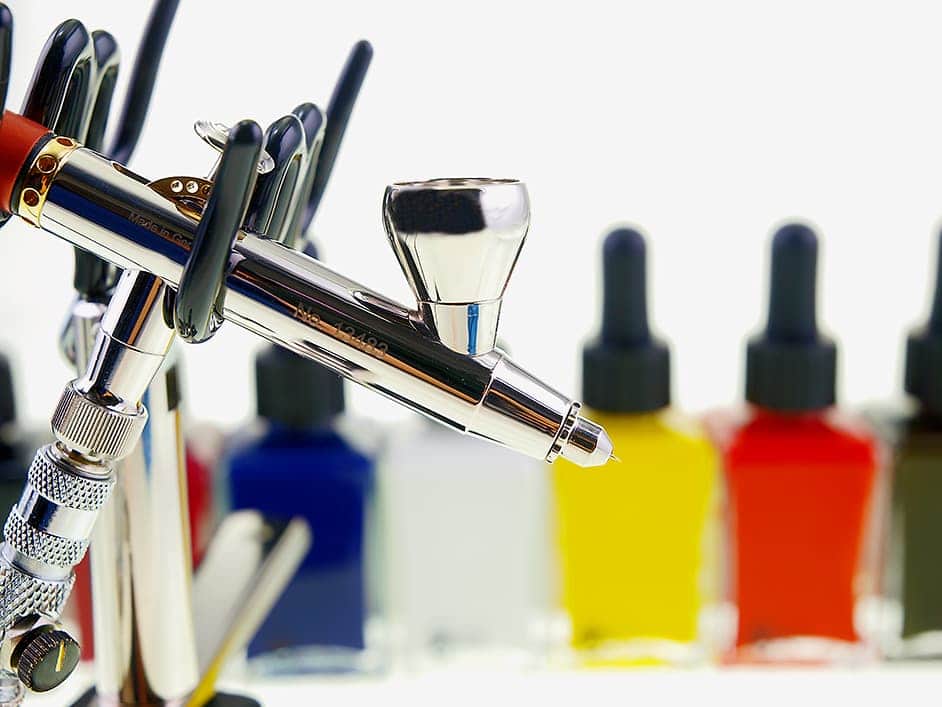
Frequently Asked Questions and Answers
Which are well-known manufacturers of airbrush paints?
Well-known and renowned airbrush paint manufacturers include the following:
- Schmincke: Schmincke offers artists everything they need for airbrushing. At present, several dozen colors and shades are available on the market. Schmincke offers natural colors as well as colors with effects. Furthermore, they have many different aids available too, such as primer, textile medium, finishing varnish, and airbrush cleaner.
- Vallejo: The company Vallejo offers the user a wide range of colors for almost every area. So model makers get their money’s worth, as well as do-it-yourselfers who work with different materials like metal and plastic.
- Liquitex: Liquitex is also a well-known company when it comes to the manufacturing of airbrush paints. Liquitex offers not only the paint, but in principle everything else that an artist’s heart desires.
Which Paints can I use for Airbrush?
In principle, all paints are suitable that are highly pigmented enough and do not dry too quickly. Acrylic paints that have been specially developed for the airbrush technique are best suited. These have very fine pigment particles and dry in a reasonable time so that the nozzle does not clog.
Whether your paints should be lacquer or water-based, you have to decide for yourself based on your planned project. If you are a model builder, you would need different paints than would, say, a passionate cake maker.
Besides, a lot of things are a matter of taste – while some people prefer the paints of Schmincke, others prefer those of Liquitex or Vallejo. As a beginner, you might have to try several manufacturers until you find the one that suits you best.
Airbrush paints are therefore somewhat special if you look at the requirements more closely. Exactly which of these are suitable for your purposes depends on your project. We trust that we have been able to give you a small overview here in our Airbrush Paints Guide.
In 2005, Charlene completed her wellness degrees in therapeutic aromatherapy and reflexology at the International School of Reflexology and Meridian Therapy. She worked for a company offering corporate wellness programs for several years before opening her own therapy practice. In 2015, she was asked by a digital marketer friend to join her company as a content creator, and it was here that she discovered her enthusiasm for writing. Since entering the world of content creation, she has gained a lot of experience over the years writing about various topics such as beauty, health, wellness, travel, crafting, and much more. Due to various circumstances, she had to give up her therapy practice and now works as a freelance writer. Since she is a very creative person and as a balance to writing likes to be active in various areas of art and crafts, the activity at acrylgiessen.com is perfect for her to contribute their knowledge and experience in various creative topics.
Learn more about Charlene Lewis and about us.
